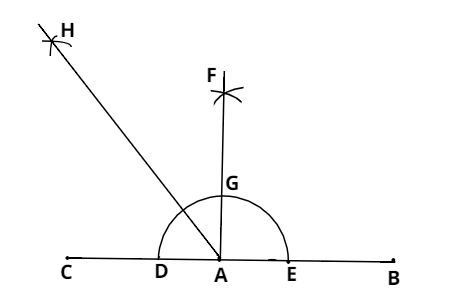
Using ruler and compasses only, draw an angle of measure of ${135^ \circ }$
Answer
607.2k+ views
Hint- This question can be solved by knowing that ${135^ \circ } = {90^ \circ } + {45^ \circ }$ .

We have to draw an angle of the measure ${135^ \circ }$.
Steps of construction: -
$\left( 1 \right)$ Draw a line segment $AB$ and produce $BA$ to point $C.$
$\left( 2 \right)$ With centre $A$ and any radius draw an arc which intersects$AC$ at $D$ and $AB$ at $E$ .
$\left( 3 \right)$ With centres $D$ and $E$ and radius more than $\frac{1}{2}DE$ ,draw two arcs which intersect each other at $F$ .
$\left( 4 \right)$ Join $FA$ which intersects the arc in $\left( 2 \right)$ at $G$ .
$\left( 5 \right)$ With centres $G$ and $D$ and radius more than $\frac{1}{2}GD$ ,draw two arcs which intersect each other at $H$ .
$\left( 6 \right)$ Join $HA$.
$\therefore \angle HAB = {135^ \circ }$
Note- Whenever we face such types of questions the key concept is that we should construct a straight angle and then draw its perpendicular bisector as we did and then we get, ${90^ \circ } + {90^ \circ }$ but, we need${90^ \circ } + {45^ \circ }$ i.e. ${135^ \circ }$ so, we draw the angle bisector of one right angle and we get $\angle HAB = {135^ \circ }$ .

We have to draw an angle of the measure ${135^ \circ }$.
Steps of construction: -
$\left( 1 \right)$ Draw a line segment $AB$ and produce $BA$ to point $C.$
$\left( 2 \right)$ With centre $A$ and any radius draw an arc which intersects$AC$ at $D$ and $AB$ at $E$ .
$\left( 3 \right)$ With centres $D$ and $E$ and radius more than $\frac{1}{2}DE$ ,draw two arcs which intersect each other at $F$ .
$\left( 4 \right)$ Join $FA$ which intersects the arc in $\left( 2 \right)$ at $G$ .
$\left( 5 \right)$ With centres $G$ and $D$ and radius more than $\frac{1}{2}GD$ ,draw two arcs which intersect each other at $H$ .
$\left( 6 \right)$ Join $HA$.
$\therefore \angle HAB = {135^ \circ }$
Note- Whenever we face such types of questions the key concept is that we should construct a straight angle and then draw its perpendicular bisector as we did and then we get, ${90^ \circ } + {90^ \circ }$ but, we need${90^ \circ } + {45^ \circ }$ i.e. ${135^ \circ }$ so, we draw the angle bisector of one right angle and we get $\angle HAB = {135^ \circ }$ .
Recently Updated Pages
Master Class 12 Business Studies: Engaging Questions & Answers for Success

Master Class 12 Economics: Engaging Questions & Answers for Success

Master Class 12 English: Engaging Questions & Answers for Success

Master Class 12 Maths: Engaging Questions & Answers for Success

Master Class 12 Social Science: Engaging Questions & Answers for Success

Master Class 12 Chemistry: Engaging Questions & Answers for Success

Trending doubts
Write a letter to the principal requesting him to grant class 10 english CBSE

Why is there a time difference of about 5 hours between class 10 social science CBSE

What is the median of the first 10 natural numbers class 10 maths CBSE

The Equation xxx + 2 is Satisfied when x is Equal to Class 10 Maths

Discuss the main reasons for poverty in India

10 examples of evaporation in daily life with explanations




